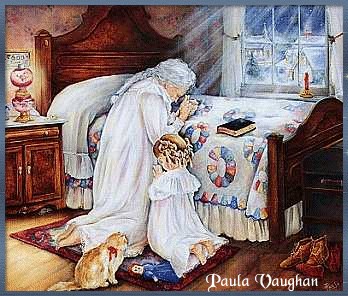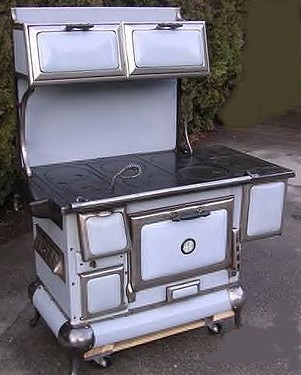Fighting at the Alamo
The Alamo became the symbol of Texas Independence
War In Texas
By 1836 there were 35,000 people in Texas with lots of room for anyone who wanted to come. It was too good to be true. Lots of acreage at bargain prices and sometimes it was free if a man would risk his life in battle. Santa Anna, the Mexican dictator, had over-ruled the Mexican Congress and nullified the Mexican constitution of 1824. Those 35,000 Americans in Texas were told to capitulate or get out. The Texans said they would honor their original agreement in the 1824 constitution but would not submit to any dictator over them (like Santa Anna). The Texans put the date 1824 on their flag at the Alamo.
So Santa Anna marched with his armies to the northern part of Mexico, the land called Texas, to put down the insurrection there. The Texans organized and sent out a cry of help to folks in the United States. Sam Houston offered free land to any man who would fight for Texas liberty.
Santa Anna destroyed the Texans in the Alamo in March of 1836 but was defeated a short time later at San Jacinto. As a result Texas became an independent nation called the Republic of Texas.
Thomas Rice in Ohio heard all the news of the fighting- the tragedies and the victories.

Recruitment of Volunteers for Texas
The war in Texas was talked about by everyone in Ohio. Appeals and propoganda were sent out.
"The Texas agents had better luck recruiting men than finding money. Davis' letter of February 24, 1836, was read to audiences all through the southwestern states. It produced violent emotional reactions in the border country. All through the Mississippi Valley friends of Texas held mass meetings to send volunteers or "armed emigrants," as Austin called them, to the war. The largest recruiting centers were New Orleans, Louisiana, and Cincinnati, Ohio. Many small companies were raised and outfitted, among them the New Orleans Grays, the Mobile Grays, the Alabama Red Rivers, and the Kentucky Mustangs. Most of these men died with Fannin at Goliad.
"Almost every Southern and border state sent men or weapons. Cincinnati sent the Twin Sisters down the Mississippi; Alabama stripped its state arsenal of muskets for Texas. Thomas Chambers, who was authorized by the Texas Council to raise an "Army of the Reserve" in the United States, successfully propagandized Ohio, Kentucky, and Tennessee. He raised and equipped almost 2,000 volunteers and sent them on their way."
Quoted from T.R. Fehrenback, Lone Star, The Macmillan Co., NY NY, 1968, pg 235
Thomas couldn't take it any more- he had to go. He thirsted for adventure and looked for new opportunity for his growing family. Americans everywhere were flocking into Texas and there was always the possibility that if he didn't act soon he would be left out.
I believe he was a hard worker, shrewd, practical, and enterprising- he was also a warrior. Texas needed men like him with all these good qualities, so he decided to go.
Tom and Liz Move to Texas 
"There was no adventure that could be compared to it, none that so stirred the imagination as leaving behind all that was known and familiar and striking out on a primitive road... for the unknown, a destination lurid with the colors of myth and legend."
Quoted from Lone Star, op.cit., page 235
They planned on leaving for Texas in the late Spring. There were 2 reasons for this:
(l) The crops had to be harvested which meant good wages for any working man whether he was a farmer or a laborer. They would need this money they earned to travel on.
(2) The rainy weather would be over which was important because rain would turn dirt roads into muddy quagmires. But they would still have to put up with was biting mosquitoes and billowing clouds of dust along the trail.
In preparation for the trip they saved their money, gathered what they would need, said their good-byes to friends, family, and loved ones, and purchased the horses and wagon. They left Ohio in June of 1836 and never came back. The family at that time consisted of Tom and Liz and their four children:
(1) James Rice (Jimmy), age 11,
(2) Mary L. Rice (Martha), age 7,
(3) Oliver Hugh Rice (Ollie), age 6, and
(4) William Wilson Rice (Billy), age 1.
 Inside of their big wagon was indispensable furniture (including a bed), a gun, seed and food supplies, a Bible, and usually some heirloom from the family of origin. The older kids had to walk much beside the moving wagon. Most stops were planned at night next to a spring, a watering hole, or next to a river so plenty of water was available for drinking, cooking, bathing, and washing pots and clothes. Blood sucking mosquitoes were always a constant problem in those days.
Inside of their big wagon was indispensable furniture (including a bed), a gun, seed and food supplies, a Bible, and usually some heirloom from the family of origin. The older kids had to walk much beside the moving wagon. Most stops were planned at night next to a spring, a watering hole, or next to a river so plenty of water was available for drinking, cooking, bathing, and washing pots and clothes. Blood sucking mosquitoes were always a constant problem in those days.

 If they needed food Tom could shoot wild game or they could purchase supplies at stores in towns or at an inn or tavern along the way. Most of the cooking that Liz and Martha did for the family was done on the tailgate of the big wagon.
(This activity gave rise to the present custom of having a tail gate party on the back of one's pickup truck at American sports games where groups of people eat and drink).
The kids could catch fish in the rivers or crawdads in the creeks after they were camped for the night. And Old Blue, the family dog, was always good for chasing down a rabbit or treeing a raccoon or squirrel. These were eaten but the eating of opossoms was optional among some families. Betsy the cow was tethered to the back and followed along behind the moving wagon. It was nice to have fresh milk and a little cheese and butter from time to time.
If they needed food Tom could shoot wild game or they could purchase supplies at stores in towns or at an inn or tavern along the way. Most of the cooking that Liz and Martha did for the family was done on the tailgate of the big wagon.
(This activity gave rise to the present custom of having a tail gate party on the back of one's pickup truck at American sports games where groups of people eat and drink).
The kids could catch fish in the rivers or crawdads in the creeks after they were camped for the night. And Old Blue, the family dog, was always good for chasing down a rabbit or treeing a raccoon or squirrel. These were eaten but the eating of opossoms was optional among some families. Betsy the cow was tethered to the back and followed along behind the moving wagon. It was nice to have fresh milk and a little cheese and butter from time to time.
Sometimes wagons would join together forming a caravan.
(When I drove a big rig truck- several big-rigs would get together traveling toward the same destination. We called it a caravan, named after the wagon train caravans of yesteryear).
While traveling south through Kentucky Tom and Liz joined their wagon to a caravan also headed for Texas. There was safety traveling in numbers and in those days folks would help one another. They got to know some of these folk quite well. Most of these families were going to Texas to get the free land. And the men might have to fight the Mexicans if they had to. So Thomas became one of them. On August 27, 1836, the caravan ended up at Valasco, the Texas capitol at that time.
There he officially signed up with the other men in the caravan with him under Captain Holmes Company of Kentucky Volunteers in the Texas Militia. This ended a long journey for him and his family as they had traveled about 1,000 miles in 2 to 3 months.

Note: a correction is to be made in one Texas book (and not repeated)- Why?
Because there were two men by the name of Thomas Rice in Texas during the time of the Texas revolution. One was a private- that is my Thomas Rice (Kentucky Volunteers). The other Thomas Rice was a first lieutenant- no relation (1'st Regiment Volunteers).
In a book written by Professor Harry L. Krenek, Ph.D, who used to teach history at Del Mar University in Corpus Christi, entitled "Death In Every Shape: The Dawsom Massacre and the Men of the Fayette Company"- the author got these two Thomas Rices mixed up in his published records. It was just an honest mistake that anyone could make.
Here is the wrong inclusion in his book:
"He also served in the 1'st Regiment Volunteers, commanded by Colonel C.S. Harrison. ("Muster Rolls of the Texas Revolution, pp. 97-98, 121, Texas State Archives," Austin).
Early Texas
In the Spring of 1836,
"In the public treaty it was agreed that Santa Anna, the Mexican General and Dictator, would cease all hostilities, that he would never take up arms against Texas, and that all Mexican Army forces would withdraw from Texas forthwith. Santa Anna was to be allowed to return to Mexico as soon as possible."
Quoted from Marshall De Bruhl, Sword of San Jacinto, Random House Pub. Inc. NY, NY, 1993, pages 216.
But Texas General Sam Houston still worried that Mexico could conquor and defeat Texas. Why?
(1) Because the Mexican General Cos was Santa Anna's brother-in-law which gave Santa Anna control over the Mexican Army in case he wanted to use it again, and
(2) Mexico outnumbered Texas. (In 1836 Mexico had a population of 8 million and Texas had a population of only 36,000). Texas could not possibly survive a massive onslaught of enemy soldiers of over 100 to 1 odds. The Texas soldiers at the Alamo were outnumbered and perished for that main reason. But there were Texas politicians who thought Texas could conquor Mexico because they believed the Mexicans lacked the will and desire to fight. But either way the Texas Army was tested under fire and victorious and was still a force to be reckoned with by the Mexican Army.
By the time Thomas M. Rice reached Texas it was an independent republic and the immediate fighting against the Mexican Army was over. Did Texas still want or need him? Oh, yes!
"All that summer (1836) Gen. Houston worried over the rumors that Texas was about to be invaded by Mexico- the "present crisis." The estimate that the Mexican Military Force was somewhere between eight thousand and twelve thousand men was, of course, inflated, but Houston did believe that an invasion was imminent and he called for more recruitment of volunteers in the United States to come to the defense of Texas."
Quoted from De Bruhl, ibid, page 223
A Look At the Thomas Rice Household
 Thomas Rice received his free land grant in Fort Bend County, Texas, in 1836. There he built a log cabin house for his family to live in, similar to the one his father built in Ohio.
"Well into the 1840's, the homes of Texas farmers were usually rough-and-ready log cabins. As one settler wrote, many houses consisted of one room that "harbored the whole family and comers and goers."
Thomas Rice received his free land grant in Fort Bend County, Texas, in 1836. There he built a log cabin house for his family to live in, similar to the one his father built in Ohio.
"Well into the 1840's, the homes of Texas farmers were usually rough-and-ready log cabins. As one settler wrote, many houses consisted of one room that "harbored the whole family and comers and goers."
 "The small farmer, who raised a few acres of cotton and perhaps a dozen cattle in order to compliment his subsistence crop of corn, still had little money to show for his labors. But every industrious farmer was able to make a decent living; and he could always trade his produce for anything he wanted, from a new plow to fine fabric for the family's Sunday best. Everyone drank coffee- lots of it- and practically everyone used tobacco in some form."
"The small farmer, who raised a few acres of cotton and perhaps a dozen cattle in order to compliment his subsistence crop of corn, still had little money to show for his labors. But every industrious farmer was able to make a decent living; and he could always trade his produce for anything he wanted, from a new plow to fine fabric for the family's Sunday best. Everyone drank coffee- lots of it- and practically everyone used tobacco in some form."
Quoted from David Nevin, The Texans, Time Life Books, NY, NY, 1975, page 163
{Note: I remember when I was three years old (1948) that my folks lived in an old run down duplex in Robstown, Texas. It was alongside the railroad tracks. We shared a centralized bathroom with two old bachelors who lived on the other side of the duplex. They chawed tobacco and when each of them sat on the throne in the bathroom he would spit tobacco juice on the walls. My mother strongly objected and we did not live there for very long!}.

 Money became very scarce in 1837, one year after Tom and Liz moved to Texas. The Panic of 1837 under the Van Buren administration plunged the United States into an economic depression. Texas was not a part of the United States at this time, but this recession also hurt many folk financially in Texas so everyone used the barter system where they traded goods. Most all farmers and cattle ranchers had to grow much of their own food.
Money became very scarce in 1837, one year after Tom and Liz moved to Texas. The Panic of 1837 under the Van Buren administration plunged the United States into an economic depression. Texas was not a part of the United States at this time, but this recession also hurt many folk financially in Texas so everyone used the barter system where they traded goods. Most all farmers and cattle ranchers had to grow much of their own food.
{My father grew up
in Texas during the Great Depression of 1929 that lasted 10 years. He traded a lot during that time because there wasn't much money. It seemed to have been ingrained in him his entire life, as from time to time when he was low on money, he would "horse trade," as he called it. Me and my brother got it from him and we did a lot of trading, even in good and plenteous times.}
Did Elizabeth have to make clothes for her children? Yes, all mothers did.

Mothers and grandmothers did that even when I was a child. When I was 5 years old living in Cal Allen, Texas, I wore home made shorts. Flour and chicken feed came in colorful cloth bags. This cloth could be used to make clothes with (I still see these kinds of cloth bags here in Calif. in the ag stores to the present day). I would pick out the design of the cloth I wanted and my folks would buy the bag. Once home we would put the contents of the sack in a large can or feed holder and then I would give the material to my grandma Rice (Wilhelmina Schulz Rice) who would cut and sew it into a nice pair of shorts for me. They helped keep me cool and I was thrilled to have them.
Clothes were hard to get and were expensive in early Texas. In Elizabeth's day a lot of mothers and girls had to spin cloth on a spinning wheel and use a loom- this is why clothes in those days were so rare and expensive. And this is why the men in the Mexican Army took the clothes off of Thomas' body after they had killed him and left his body laying naked on the ground. It was not anything personal. That was just the way they did things in those days.
Part of the fun of creating such a web page is using one's imagination to see how things were in those days. Here is some clipart of some items of use in those times. I am sure Tom and Liz owned them all. Any antique dealer would love to get his hands on originals now! Let's take a look inside of their house.


And if we take a look around their yard what do you think we might see?
The Thomas Rice Family House is Rain-soaked
A big hurricane leveled Galveston, Texas in the fall of 1837. With high velocity winds and torrential rain it hit all on the Texas plain. Tom and Liz's house got rain soaked- everything that they had brought with them from Ohio got wet. I imagine that this tragedy triggered a remembrance for him back to the days in Ohio when he was a boy of the earthquake that shook his home apart. Many people got flooded and swept away in the flood waters that fall when the rivers over flowed their banks. But no loss of life happened to Tom and his family. Everything they had (that had gotten wet) had to be dried off and made useable again. It was just one setback they overcame besides the financial depression- but the biggest setback was still ahead of them- and it would happen to them during the war.
The Movements Of The Thomas M. Rice Family in Texas
The movements of the Thomas McClure Rice family are not hard to trace. They received their land grant in Fort Bend County, Texas, in 1836. Thomas Rice is listed in the June 1840 census of Texas as living in Fort Bend County. They were still poor, owning only one saddle horse. His job was being a cowboy so he needed this horse. 13 months later his name appears in the Texas Sentinel Newspaper for being delinquent in the payment of his property taxes in Fort Bend County in the amount of $1.25. However, in the fall of 1841 they moved to the Cuero area (Gonzales County at that time but present-day De Witt County). I have been to this area and it resembles greatly the area he came from in Ohio so it must have seemed familiar to him. We know when he moved because his youngest son, Thomas Richard Rice, was born in Cuero in February of 1842, but they maintained ownership of their land in Fort Bend County for awhile.
Texas Politics 
Texas, under President Houston, held a defensive posture politically, but the new Texas president, Mirabeau Lamar, began an offensive series of movements with the view of invading Mexico. In the spring of 1841 Lamar dispatched "a trading expedition" to Santa Fe in Mexican territory with the hopes of adding New Mexico territory to Texas to make Texas an ever greater nation. This invasion of Mexico provoked Mexico against Texas.
A few years earlier there was a scheme to invade Mexico and capture Metamoros, but President Houston fought against and killed that idea.
"The most dangerous congressional measure he confronted was an act of war disguised as "an act to define the boundaries of Texas." In a breath taking display of imperialism, the (Texas) House of Representatives passed a bill extending the boundaries of Texas to include two thirds of Mexico. It was, of course, Lamar's old dream of extending the territorial limits all the way to the Pacific Ocean."
Quoted from De Bruhl, The Sword of San Jacinto, op.cit., page 292
I am including a brief history here in regards to the conflict between Mexico and Texas. If you are not interested in reading about this conflict, just skip over this section in the smaller green print. I place this history here because certain actions in this war are the "stepping stones" to the Battle of Salado.

"Texas had only been a Republic for 6 years, and during the spring and summer of 1842, a great interest was felt throughout the Republic for the annexation of Texas to the United States, but Mexico hated the idea that Texas might become a part of the United States.
The Mexican authorities, of course, threw every obstacle in the way of this union that was in their power, and sent out the expedition under General Woll. Their expressed intention was to march through the territory; but their real intention was to make a raid, and thus delay, and if possible, thwart annexation, hoping in the end to induce Texas to submit to Mexican rule.
In the meantime President Houston had been trying to bring pressure on Mexico through the mediation of the strong foreign powers. The United States, as we have seen, recognized the independence of Texas in March, 1837, by accrediting to the republic a charge d�affaires. France recognized it by concluding a treaty of commerce and friendship on September 25, 1839, which was ratified on February 14, 1840. British recognition was obtained in a series of treaties concluded in November 1840, but these were not ratified until June 28, 1842. One of these British treaties was an agreement on the part of England to urge upon Mexico the recognition of Texas, and Lord Aberdeen on July 1, 1842, instructed the British charge at Mexico to make the necessary representation to the Mexican government. This was done, but the overture was rejected. Immediately following the ratification of the British treaties an effort was made to get France, England, and the United States to make a joint demand on Mexico for recognition. But
England refused to become a party to this tripartite action. At the same time, however, Lord Aberdeen suggested that the three governments might make identical representations on the subject to the Mexican government. Appropriate instructions were accordingly issued to the diplomatic agents of England and France for making such a representation, but these agents, knowing the uselessness of such action, did nothing.
On October 15, 1842, just after the retreat of General Woll from San Antonio, President Houston again appealed to the powers to use their influence to compel Mexico either to recognize the independence of Texas "or to make war upon her according to the rules established and universally recognized by civilized nations."
"It has now been nearly seven years since the declaration and the establishment of the independence of this republic. During the whole of this time Mexico, although uniformly asserting the ability and determination to re-subjugate the country, has never made a formidable effort to do so. Her principal war has consisted of silly taunts and idle threats, of braggadocio bulletins and gasconading proclamations. All her boasted threats of invasion have resulted in nothing more than fitting out and sending into the most exposed portions of our territory petty marauding parties, for the purpose of pillaging and harassing the weak and isolated settlements on our western border."
Mexico �s object, he said, was merely to keep alive its claim to Texas and to retard the development of the country by threats that it had neither the intention nor the means to carry out.
Daniel Webster was secretary of state at this time in the United States, and on November 12, 1842, he instructed Waddy Thompson. the American charge at Mexico, to urge recognition. The United States saw with pain the preparations for war..."
Quoted from Frank W. Johnson, "A History Of Texas And Texans."
So due to the above reasons, a war began cooking with Mexico that would eventually get Thomas M. Rice killed.
Sad News From Ohio
In 1841 Tom learned that his daddy, Nathan Rice, had died. Tom could not be there for the funeral but he was comforted in knowing that Nathan had an honorable burial in the Rainbow Cemetery complete with a gravestone. His mother, sisters and their families had taken care of it all.
{Note: I have been to Ohio and visited his grave site. It is well preserved to this day. There was a small American flag flying from it placed there by the DAR (Daughters of the American Revolution) saluting him for his patriotism and service during the Revolutionary War).
Mail and package deliveries in Texas in those days were made by
"local freight and stage-coach companies under contract to the government."
Tom received a large package sent by his mother in Ohio containing the clothing of Nathan Rice as willed to him in his father's will. It is sad to think that Thomas may have been wearing his daddy's clothes a year later when he was killed in battle.
Quoted from Nevin, op. Cit., page 170
I can just imagine the interest and curiosity of the Thomas Rice Family children after that parcel arrived. This was a great opportunity for Tom to tell his children stories about his father and grandfather, especially how they were both heroes of the Revolutionary War. It might have been the last time he ever told them those stories because a year or so later he would be killed in action.
The Mexican Army Invades Texas in the Spring of 1842
"However, Mirabeau Lamar had succeeded at last in arousing Mexico, and Houston inherited the minor whirlwind the Buonaparte of Texas had stirred up. Santa Anna had bided his time and was again President of Mexico. Fired by the belief that Mexico, to keep any international belief in its sovereignty over Texas and to prevent further raids like the one on Santa Fe (trying to grab land), had to do something, Santa Anna sent an expedition north across the Rio Grande, in the spring of 1842. This was not an attempt to reconquer Texas; it was a show of force. The Mexican army easily captured San Antonio, Refugio, and Goliad- this time unopposed. Mexican Gen. Rafael Vasquez did nothing, however, but occupy the cities, raise the Mexican flag, inspect Texan defenses, and withdraw."
Quoted from T.R. Fehrenback, op. Cit., page 261
The Battle of Salado
The Mexican Army Invades Texas in the Fall of 1842
On the morning of September 11, 1842, a Mexican Army captured San Antonio, Texas, in a lightning fast move. General Adrian Woll was in command. He was a Belgian mercenary but was born in France. His name was pronounced "Gual" in the native French. He caught the Texans there completely by surprise. He commanded a force of 1450 infantry, cavalry and artillery troops and captured the town without a shot being fired in it's defense. He decided to wake up the surprised citizens of San Antonio that morning with the sounds of his "noise only" cannon fire.
"However, news of the invasion spread rapidly to the former DeWitt Colony settlements of Seguin, Gonzales and the Lavaca River as well as into the settlements on the Colorado and Brazos Rivers via couriers who had escaped imprisonment.
In San Antonio the District Court of the Republic of Texas had been in session under Judge Anderson Hutchison since the first of September with attendance by many area officials and lawyers from as far away as Gonzales. The advocates had no choice but to surrender to General Woll�s forces under conditions that they would be treated as gentleman. After five days, about 55 prisoners were told that they would have to march to the Rio Grande where they would be handed over into the custody of his superior, General Reyes and likely be set free."
Quoted from Adam Zumwalt Jr., Captain "Black" Adam Zumwalt in the Battle of Salado- Dawson Massacre
Houston was emotionally aggravated by this news. He issued mobilization orders to the Texas militia to expel the invaders and pursue them into Mexico if necessary so
"that they should receive that chastisement which the injuries inflicted upon us imperiously demand."
Houston's attitude appeared to be: Santa Anna can capture San Antonio but let's see if he can hold it.
Quoted from DeBruhl, Sword of San Jacinto, op.cit., page 298
The Mexicans held San Antonio for nine days. They marched off their prisoners to Mexico and waited to see what the Texans would do next. Santa Anna wanted to make sure that the messages he was sending to Texas was crystal clear. Did these actions prevent this? No. Texas still joined with the United States, and during the Mexican War with the United States, Mexico lost a great deal more land including what is now the states of Arizona, New Mexico, Nevada, and California.
 Texas president Houston ordered Colonel Mathew Caldwell of the Texas Army at Gonzales, Texas, to gather together the Texas minutemen and militia to attack Gen. Woll at San Antonio. Caldwell gathered a militia of 225 men at the Cibolo River on the San Antonio Road above Seguin and marched toward San Antonio. Some of these troops included former prisoners involved in the unsuccessful Santa Fe expedition including Colonel Mathew Caldwell. On September 17, his troops made camp about 6 miles east of San Antonio below present New Braunfels at Salado Creek and planned their attack on the Mexicans.
Texas president Houston ordered Colonel Mathew Caldwell of the Texas Army at Gonzales, Texas, to gather together the Texas minutemen and militia to attack Gen. Woll at San Antonio. Caldwell gathered a militia of 225 men at the Cibolo River on the San Antonio Road above Seguin and marched toward San Antonio. Some of these troops included former prisoners involved in the unsuccessful Santa Fe expedition including Colonel Mathew Caldwell. On September 17, his troops made camp about 6 miles east of San Antonio below present New Braunfels at Salado Creek and planned their attack on the Mexicans.
On September 18, Caldwell sent a force of Texas Rangers headed by Captain John C. (Jack) Hays to draw the Mexicans toward the battlefield he had chosen. Their military mission was to lure the greater Mexican force toward the force of 202 Texans. The Texans had the battlefield chosen to their advantage.
"From a ridge 300 to 400 yards from the Alamo, Hays men waved, shouted and challenged the enemy to come out of the Alamo onto the field, as if they were preparing for battle. The actions resulted in a charge of over 400 Mexican cavalrymen out of the Alamo, which turned to a hot pursuit when Capt. Hays and the company turned around and appeared to be running away toward the Salado River. Some distance out, the horse of Captain Augustus H. Jones of Gonzales, a close personal friend of Captain Hays, began to fall behind in relation to the others in the main force. Captain Hays put the entire company just behind Captain Jones with his slower mount leading the way. This contingent led the Mexican force across the Salado River right to Capt. Caldwell's waiting men, hidden in the sunken river bed of brushy bottom land."
Quoted from Adam Zumwalt Jr., Captain "Black" Adam Zumwalt in the Battle of Salado- Dawson Massacre
The Mexican cavalry charged Caldwell's position but many of their soldiers were shot off of their horses. They dismounted and formed a skirmishing line, firing for 3 hours. They sent word to General Woll who marched out of San Antonio with an estimated 850 Mexican soldiers and 2 cannons to attack the Texans.
The Mexican Army attacked across open ground in front of Caldwell's men. They were cut to pieces. The front lines of the Mexican infantry were forced to fall back behind their cannons for cover, out of rifle range. They made several smaller charges that were repulsed with heavy casualties.
"Col. Caldwell and the Texans- in good concealment in the Salado bottom- resisted the Mexican attack, killed 60 Mexicans and wounded many more, with only one Texan killed and 9 wounded."
Quoted from Gen. Thomas Green's Journal of the Texian Expedition Against Mier.
In this battle "Caldwell was doing splendidly, because he knew how to fight both Mexicans and Indians and knew better than to give either an even break. The Mexican cavalry could not ride into his timbers and no Mexican infantry force of only three-to-one could assault Texas rifles firing from cover."
Quoted from Fehrenbach, ibid, page 478
But just as the frontal fight ceased between Caldwell and the Mexicans another battle started. Capt. Nicholas Mosby Dawson showed up with fifty-three Texas minutemen who attacked Woll's rear guard troops. There was quite a battle and several Mexican soldiers were killed and wounded. Dawson was trying to join Caldwell but was at a tactical disadvantage and out-numbered. Him and his men were soon placed on the defensive and defeated.
Texas General Green stated,
"Gen Woll, sorely disappointed in driving the Texian wolves from the bush, was about retreating when he was informed a company of Texians was advancing upon his rear, some two miles distant. This company proved to be the gallant and lamented Captain Dawson and his 53 men, mostly from Fayette Co., who had determined upon succouring Caldwell; and it proved a favorable opportunity for General Woll to withdraw from Caldwell without the appearance of flight; consequently, he retreated to some distance and dispatched a large portion of his force to attack Dawson."
Quoted from Gen. Thomas Green's Journal of the Texian Expedition Against Mier.
At sundown, Gen. Woll carried his dead and wounded off of the 2 battlefields. His army returned to San Antonio for the night and then retreated over the Rio Grande River back into Mexico. General Woll had delivered Santa Anna's messages to Texas bureaucrats
written in blood.
The Texas Dawson Expedition 
It is my great delight to share with you the complete story of the Dawson Expedition as I understand it. I place this story here because Thomas M. Rice was killed in this battle.
Dictator Santa Anna of Mexico received a letter dated March 21, 1842 from Sam Houston of Texas, which said: "Every citizen of Texas was born a free man, and he would be a recreant to the principles imbibed from his ancestry if he would not freely peril his life in defense of his home, his liberty and his country."
"Ever ready to fight, Fayette County was not slow in answering John Hays' urgent call for volunteers to San Antonio. Hays' runners had left San Antonio on Sunday, Sept. 11. By the following Friday, Capt. Nicholas M. Dawson had assembled the nucleus of his band under the historic oak at LaGrange. The band numbered 15 or more. Leaving at once, these men crossed the Colorado on the ferry, near the present old bridge."
"Small groups of volunteers joined Dawson's company on the horseback march to San Antonio, augmenting their number to 53. "They crossed the Colorado River on a ferry run by a Mr. McAhron where they were joined by John Bradley and Francis E. Brookfield. Mrs. Samuel Augustus Maverick, wife of Samuel Maverick, who had been captured during the takeover of San Antonio on 11 September was at the home of Bradley who was her uncle. The contingent moved along the Old Seguin Road which stretched from La Grange through Cedar, O'Quinn, Black Jack Springs, Muldoon, Colony, Elm Grove and Waelder on the way to Seguin toward San Antonio. Between O'Quinn and Black Jack Springs, they were joined by 70 year old David Berry and son-in-law Harvey Hall. Capt. Patrick Lewis and preacher's sons Allen H. Morrell and John Dancer joined them near Black Jack Springs. A group of men from Wood's Prairie near West Point joined at the Ivy School House. They were Joseph C. Robinson, Zed Barkley and sons Robert and Richard Barkley, 69 year
old Zadock Woods and sons Norman B. and Henry Gonsalvo, William James Trimble and brother Edward, Norman Miles Wells (nephew of Zadock Woods' wife) and John Wesley Pendleton (nephew of the younger Woods boys). Near Waelder, they were joined by Milvern Harrell (brother-in-law to Pendleton) and Richard Slack."
"Passing Waelder, they were overtaken by two current Lavaca County residents, John Cummings and W.D. Patterson. Residents from the area, now DeWitt County, Thomas J. Butler, Elijah Garey, Thomas Rice and William Savage caught up with the group near the same area. On down the Seguin Road, the Negro slave of Samuel A. Maverick, Joe Griffin, caught up with the group. He was heavily armed and carrying a ransom sent by Mrs. Maverick for release of her husband. Somewhere near Nash's Creek about 15 miles west of Gonzales, Alsey Miller joined the group from the company of Capt. Jesse Billingsley which was still forming for the trip to San Antonio. Capt. Dawson could not be persuaded to wait for Capt. Billingsley who suggested that they march to San Antonio together. A Mr. Adams, Charles Fields, Thompson D. James, Asa Jones, John Jones, William Linn and John McCrady joined the Dawson group somewhere on the journey. At camp near Nash's Creek, Capt. Dawson was elected Captain and Dickerson Lieutenant."
"A courier, John Wilson, from Capt. Caldwell urging reinforcements and describing his location apparently stimulated Capt. Dawson to embark essentially on a forced march. All day Friday and part of the night was spent lessening the distance to the beleagured Alamo City which resulted in reaching Seguin at daylight on 17 Sept. about 45 miles from Salado. Breaking camp early on the morning of Sept. 17, Dawson and his men pressed forward on a march that demanded the last ounce of energy from fatigued horseflesh. With everything sacrificed to speed, there seems to have been no camp made on Saturday night. Apparently no halt was made until the Cibolo River was reached in the early morning hours of the fateful Sunday, Sept. 18, 1842. Both men and horses arrived exhausted."
Quoted from Adam Zumwalt Jr., Captain "Black" Adam Zumwalt in the Battle of Salado- Dawson Massacre
Scouts were sent forward from here in an effort to locate Caldwell and his company, but they apparently found Mexicans instead. Alsey S. Miller- a scout by virtue of having the only fresh horse in the band and being acquainted with the territory- was sent forward to contact Caldwell. Miller never reached him. The Battle of Salado was being fought, and Miller approached only close enough to ascertain this fact. Miller hurried back to Dawson's camp. On the way, he was charged by three Mexican cavalrymen and in the fight which ensued Miller killed one of them and eluded the others, making his way safely back to Dawson.